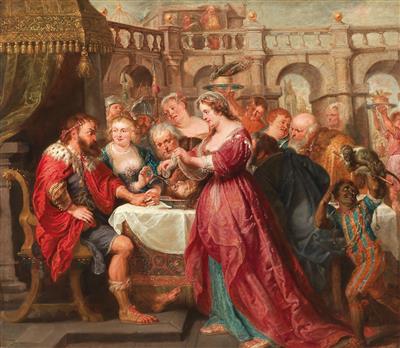Workshop of Peter Paul Rubens

(Siegen 1577–1640 Antwerp)
The Feast of Herod,
oil on canvas, 138 x 162 cm, framed
The present painting is an important rediscovery from the workshop of Peter Paul Rubens. The Feast of Herod is a composition dating from Rubens’s late period (circa 1638–40), which according to Max Rooses, author of the early catalogue raisonné, brought forth some of the master’s most impressive inventions. The present work once more betrays the unbroken force of Rubens’s narrative description of his themes in the ironic interpretation of a barbaric biblical event that is carried here to grotesque extremes. Rubens has imaginatively re-enacted the cruelty of the scene.
vOnly a few versions of this composition from Rubens’s Antwerp studio are known, all of which date from the time shortly before the master’s death. A sketch in which Rubens has outlined the protagonists Salome, Herod, and his wife Herodia has survived (Museum of Art, Cleveland/Ohio, inv. no. 54.2). Unsatisfied with this first design, he made corrections to the figure of Salome, all of which were finally carried out in the few painted versions that have come down to us. A large-sized painting in the National Gallery of Scotland, Edinburgh (inv. no. NG2193), is believed to be the prototype, which differs from the present painting in several conspicuous details. Whereas in the Edinburgh painting the architecture in the background was inspired by Italian examples that Rubens vividly remembered from his journey to Italy, the structure of an inner courtyard in the present painting is rather based on the lower storeys of the Rubenshuis in Antwerp. This and further modifications – for example, the page in the Edinburgh painting is light-skinned and the hands of Herod and Herodia are not intertwined – suggests that the collaborator in question, whose identity has not yet been successfully clarified, had a certain standing within the workshop hierarchy. Supervising the production of his workshop, Rubens acted as a guarantor of quality, but also granted talented assistants artistic licence in the completion of his commissions.
Specialist: Dr. Alexander Strasoldo
 Dr. Alexander Strasoldo
Dr. Alexander Strasoldo
+43-1-515 60-556
alexander.strasoldo@dorotheum.at
25.04.2017 - 18:00
- Realized price: **
-
EUR 40,965.-
- Estimate:
-
EUR 40,000.- to EUR 60,000.-
Workshop of Peter Paul Rubens
(Siegen 1577–1640 Antwerp)
The Feast of Herod,
oil on canvas, 138 x 162 cm, framed
The present painting is an important rediscovery from the workshop of Peter Paul Rubens. The Feast of Herod is a composition dating from Rubens’s late period (circa 1638–40), which according to Max Rooses, author of the early catalogue raisonné, brought forth some of the master’s most impressive inventions. The present work once more betrays the unbroken force of Rubens’s narrative description of his themes in the ironic interpretation of a barbaric biblical event that is carried here to grotesque extremes. Rubens has imaginatively re-enacted the cruelty of the scene.
vOnly a few versions of this composition from Rubens’s Antwerp studio are known, all of which date from the time shortly before the master’s death. A sketch in which Rubens has outlined the protagonists Salome, Herod, and his wife Herodia has survived (Museum of Art, Cleveland/Ohio, inv. no. 54.2). Unsatisfied with this first design, he made corrections to the figure of Salome, all of which were finally carried out in the few painted versions that have come down to us. A large-sized painting in the National Gallery of Scotland, Edinburgh (inv. no. NG2193), is believed to be the prototype, which differs from the present painting in several conspicuous details. Whereas in the Edinburgh painting the architecture in the background was inspired by Italian examples that Rubens vividly remembered from his journey to Italy, the structure of an inner courtyard in the present painting is rather based on the lower storeys of the Rubenshuis in Antwerp. This and further modifications – for example, the page in the Edinburgh painting is light-skinned and the hands of Herod and Herodia are not intertwined – suggests that the collaborator in question, whose identity has not yet been successfully clarified, had a certain standing within the workshop hierarchy. Supervising the production of his workshop, Rubens acted as a guarantor of quality, but also granted talented assistants artistic licence in the completion of his commissions.
Specialist: Dr. Alexander Strasoldo
 Dr. Alexander Strasoldo
Dr. Alexander Strasoldo
+43-1-515 60-556
alexander.strasoldo@dorotheum.at
|
Buyers hotline
Mon.-Fri.: 10.00am - 5.00pm
old.masters@dorotheum.at +43 1 515 60 403 |
| Auction: | Old Master Paintings |
| Auction type: | Saleroom auction |
| Date: | 25.04.2017 - 18:00 |
| Location: | Vienna | Palais Dorotheum |
| Exhibition: | 15.04. - 25.04.2017 |
** Purchase price incl. charges and taxes(Country of delivery: Austria)
It is not possible to turn in online buying orders anymore. The auction is in preparation or has been executed already.
